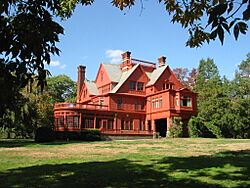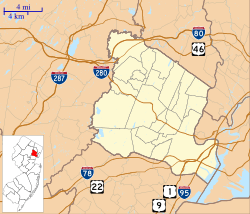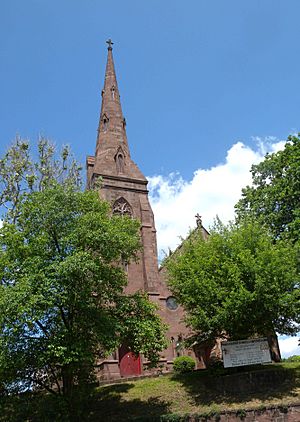West Orange, New Jersey facts for kids
Quick facts for kids
West Orange, New Jersey
|
|||
|---|---|---|---|
|
Township
|
|||

Glenmont, part of the Thomas Edison National Historical Park located in Llewellyn Park
|
|||
|
|||
| Motto(s):
"Where Invention Lives"
|
|||
| Country | |||
| State | |||
| County | Essex | ||
| Incorporated | April 10, 1863 (as township) | ||
| Reincorporated | February 28, 1900 (as town) | ||
| Government | |||
| • Type | Faulkner Act (mayor–council) | ||
| • Body | Township Council | ||
| Area | |||
| • Total | 12.13 sq mi (31.41 km2) | ||
| • Land | 12.00 sq mi (31.09 km2) | ||
| • Water | 0.12 sq mi (0.32 km2) 1.01% | ||
| Area rank | 189th of 565 in state 3rd of 22 in county |
||
| Elevation | 512 ft (156 m) | ||
| Population
(2020)
|
|||
| • Total | 48,843 | ||
| • Estimate
(2023)
|
47,871 | ||
| • Rank | 39th of 565 in state 5th of 22 in county |
||
| • Density | 4,069.2/sq mi (1,571.1/km2) | ||
| • Density rank | 154th of 565 in state 14th of 22 in county |
||
| Time zone | UTC−05:00 (Eastern (EST)) | ||
| • Summer (DST) | UTC−04:00 (Eastern (EDT)) | ||
| ZIP Code |
07052
|
||
| Area code(s) | 973 | ||
| FIPS code | 3401379800 | ||
| GNIS feature ID | 1729718 | ||
West Orange is a town in Essex County, New Jersey. It's a suburb located close to Newark and about 12 miles west of New York City. In 2020, West Orange had a population of 48,843 people. This town is famous for being the home of the inventor Thomas Edison, who had his laboratory and workshop here.
Contents
- History of West Orange
- Early Native American Life
- European Settlement and Conflicts
- Founding of Newark and Westward Expansion
- First European Settlers
- West Orange During the American Revolution
- Becoming a Separate Township
- West Orange as a Resort and Innovation Hub
- Thomas Edison's Legacy
- Industrial Past and Modern Development
- Geography of West Orange
- Population and People
- Economy and Shopping
- Sports and Recreation
- Landmarks and Places to Visit
- Education in West Orange
- Transportation in West Orange
- Media and Communications
- Notable People from West Orange
- See also
History of West Orange
West Orange has a long and interesting history. For over 10,000 years, the land was home to the Native American Hackensack clan. They were part of the Lenni Lenape tribe, who called themselves "the original people." They were hunter-gatherers and believed in living in harmony with nature. Old trails like Northfield Avenue and Old Indian Road in West Orange are still used today.
Early Native American Life
The Hackensack people were known as "Delaware Indians" by the 1700s. They identified with the turtle totem. They hunted and gathered food, traveling to the ocean or mountains. The Passaic River and Watchung Mountains were important landmarks. The South Mountain Reservation has rocks that look like turtle backs. This area is now called "Turtle Back Rock Picnic Area" and gave its name to the Turtle Back Zoo. These rocks were special to the Native Americans.
European Settlement and Conflicts
Native Americans did not "own" land in the same way Europeans did. They believed in taking only what was needed from nature. This belief helped early European settlers, who struggled at first. In the 1500s and 1600s, different European groups like the Dutch, Scottish, Swedes, and English fought over the land.
In 1664, the English took control of the area from the Dutch. They bought a large piece of land from the Hackensack people. This was called the "Elizabethtown Purchase." However, the Hackensack tribe disagreed about what was included. Later, in 1667, the English made another agreement.
Founding of Newark and Westward Expansion
In 1666, Captain Robert Treat from Connecticut bought land west of the Passaic River. He founded "New Ark," which is now Newark. Newark grew westward, taking over more Hackensack land. This expansion happened as individual landowners bought small pieces of land.
First European Settlers
In 1678, Anthony Olive, a Dutch settler, was the first European to live in what is now West Orange. He started a farm at the base of the mountains. By 1706, West Orange was part of Essex County.
West Orange During the American Revolution
During the American Revolution, West Orange was known as part of the Newark Mountains. The area had many farms and mills. A place on Main Street, now called "Tory Corner," was once named Williamstown. It was named after two brothers, Nathaniel and Benjamin Williams.
Nathaniel Williams and his two oldest sons supported the British. They joined the British Army in 1777 and never came back. Nathaniel died of smallpox in New York. However, Nathaniel's wife, Mary Williams, stayed on their farm with her younger children. She helped George Washington's revolutionary troops. A plaque was put up in 1922 to honor Mary Williams.
Becoming a Separate Township
West Orange was originally part of Newark township. In 1806, the area that includes all of The Oranges became Orange Township. Orange then started to split into smaller towns. This happened because of disagreements over the costs of police, fire, and street departments.
South Orange was formed in 1861, and East Orange in 1863. West Orange became a township on April 10, 1863. It later became a town in 1900. In 1980, West Orange changed back to a township. This was done to get more government funding. The town's name comes from William III of England or William IV, Prince of Orange.
West Orange as a Resort and Innovation Hub
The Eagle Rock Reservation covers 400 acres in West Orange. It was once home to many eagles. The Lenni Lenape Trail starts here. Rock Spring, located at Northfield Avenue and Walker Road, was believed to have healing powers. In the 1800s, people from New York City visited West Orange to drink its water. West Orange became a popular resort with boating, fishing, and an amusement park.
Llewellyn Park, America's first planned community, is in West Orange. It was designed in 1857. It's a great example of the "Romantic Landscape" style.
Thomas Edison's Legacy
Thomas Edison lived in West Orange. His laboratory, now the Thomas Edison National Historical Park, is where he invented many things. He earned over 1,000 patents, including the light bulb and recorded sound. The laboratory also had the Black Maria, America's first movie studio. The idea of the movie industry started right here in West Orange.
The movie industry grew quickly in the area. Later, many studios moved to Fort Lee, New Jersey. Eventually, they moved to Hollywood, California, for better weather and to avoid Edison's company rules.
Industrial Past and Modern Development
In the late 1800s, West Orange was known as the country's hat-making capital. It had 34 hat factories. This area is now being redeveloped as 'Hat City' or 'The Valley Arts District'. The Orange Quarry Company, which mined bluestone, operated in West Orange until 1983.
After World War II, West Orange saw a building boom. In the 1960s, more people moved to West Orange. The opening of Interstate 280 in 1970 made it a popular place for people who commute to New York City. By the 1990s, West Orange became a diverse community with people from many different countries.
Today, West Orange is home to the Kessler Institute, a rehabilitation center. It also has many Jewish synagogues and Korean churches.
Geography of West Orange
West Orange covers about 12.13 square miles. Most of this is land, with a small amount of water. It is about 5 miles west of downtown Newark. The town is part of the New York metropolitan area.
The West Branch of the Rahway River starts at Crystal Lake and flows through the town. West Orange borders several other towns in Essex County. These include Essex Fells, Livingston, Millburn, Maplewood, Montclair, Orange, Roseland, South Orange, and Verona.
West Orange Neighborhoods
West Orange has several distinct neighborhoods. These areas often match the town's geography.
Downtown West Orange and The Valley
This is the oldest and most crowded part of town. It sits in a low area along the eastern border. Main Street here is home to the Thomas Edison National Historical Park. You'll also find the town hall, police station, and a post office. The West Orange Public Library is nearby. This area feels more like a city. The Valley has a growing arts district and a large African American community.
The First Mountain
West of Downtown, the neighborhoods become more suburban. They climb the steep First Watchung Mountain. Homes here include Victorian, Jazz Age, and Tudor styles. There are also large estates and modern houses. Llewellyn Park, one of America's first planned neighborhoods, is on this mountain. Many blocks offer amazing views of the Newark and New York City skylines.
Pleasant Valley and Pleasantdale
Beyond Prospect Avenue, West Orange changes into suburban neighborhoods built after World War II. You'll find older Victorian homes, golf courses, and shopping centers. Pleasantdale has a walkable business area with restaurants, offices, and stores. It is also home to a large Orthodox Jewish community.
The Second Mountain
The westernmost part of West Orange is along the Second Watchung Mountain. It includes large parts of the South Mountain Reservation. The homes here are similar to those in Pleasantdale and nearby towns like Millburn and Livingston.
Population and People
| Historical population | |||
|---|---|---|---|
| Census | Pop. | %± | |
| 1870 | 2,106 | — | |
| 1880 | 3,385 | 60.7% | |
| 1890 | 4,358 | 28.7% | |
| 1900 | 6,889 | 58.1% | |
| 1910 | 10,980 | 59.4% | |
| 1920 | 15,573 | 41.8% | |
| 1930 | 24,327 | 56.2% | |
| 1940 | 25,662 | 5.5% | |
| 1950 | 28,605 | 11.5% | |
| 1960 | 39,895 | 39.5% | |
| 1970 | 43,715 | 9.6% | |
| 1980 | 39,510 | −9.6% | |
| 1990 | 39,103 | −1.0% | |
| 2000 | 44,943 | 14.9% | |
| 2010 | 46,207 | 2.8% | |
| 2020 | 48,843 | 5.7% | |
| 2023 (est.) | 47,871 | 3.6% | |
| Population sources: 1870–1920 1870 1880–1890 1890–1910 1900–1930 1900–1990 2000 2010 2020 |
|||
West Orange is a diverse community. The population has grown steadily over the years.
Population in 2020
In 2020, West Orange had 48,843 people. The town is made up of many different racial and ethnic groups.
| Race / Ethnicity (NH = Non-Hispanic) | Pop 1990 | Pop 2000 | Pop 2010 | Pop 2020 | % 1990 | % 2000 | % 2010 | % 2020 |
|---|---|---|---|---|---|---|---|---|
| White alone (NH) | 33,015 | 27,907 | 22,140 | 19,155 | 84.43% | 62.09% | 47.91% | 37.68% |
| Black or African American alone (NH) | 2,142 | 7,672 | 11,841 | 13,916 | 5.48% | 17.07% | 25.61% | 27.31% |
| Native American or Alaska Native alone (NH) | 41 | 38 | 80 | 53 | 0.10% | 0.08% | 0.17% | 0.10% |
| Asian alone (NH) | 2,140 | 3,619 | 3,641 | 5,523 | 5.47% | 8.05% | 7.87% | 10.85% |
| Pacific Islander alone (NH) | N/A | 13 | 9 | 18 | N/A | 0.03% | 0.02% | 0.04% |
| Some Other Race alone (NH) | 37 | 120 | 142 | 436 | 0.09% | 0.27% | 0.31% | 0.86% |
| Mixed Race or Multi-Racial (NH) | N/A | 1,060 | 867 | 2,095 | N/A | 2.36% | 1.88% | 4.12% |
| Hispanic or Latino (any race) | 1,728 | 4,514 | 7,487 | 9,647 | 4.42% | 10.04% | 16.19% | 18.97% |
| Total | 39,103 | 44,943 | 46,207 | 48,843 | 100.00% | 100.00% | 100.00% | 100.00% |
Population in 2010
In 2010, West Orange had 46,207 people. About 57% were White, 26% Black or African American, and 7% Asian. About 16% of the population was Hispanic or Latino. The average household had 2.70 people. The average family had 3.28 people. About 23.7% of the population was under 18 years old. The median age was 40.6 years.
Economy and Shopping
Essex Green Shopping Center is a large outdoor mall in West Orange. It has stores like ShopRite, restaurants, and a movie theater where you can dine while watching a film. This mall is the biggest of its kind in Essex County.
Sports and Recreation
West Orange has a strong sports community. The Jersey Rockhoppers hockey team used to play their home games at the Richard J. Codey Arena. This arena was also the practice facility for the New Jersey Devils hockey team for many years.
The New Jersey Daredevils, a special needs hockey team, also uses the arena. They host a Halloween-themed tournament called Frankenfest every October. The New Jersey Devils Youth Hockey team plays here too.
Parks and Outdoor Activities
West Orange is known for its two large parks. The South Mountain Reservation is along its southwestern borders. The Eagle Rock Reservation is along its northeastern borders. These parks offer great opportunities for outdoor fun. You can go fishing and kayaking on the Rahway River.
Landmarks and Places to Visit
- Thomas Edison National Historical Park: Explore the laboratory and home of the famous inventor.
- Turtle Back Zoo: A popular zoo named after the unique rock formations nearby.
- South Mountain Reservation: A large park with beautiful scenery and trails.
- Eagle Rock Reservation and 9/11 Memorial: Another large park with stunning views and a memorial.
Education in West Orange
West Orange Public Schools serves students from pre-kindergarten through twelfth grade. The district has 12 schools and over 6,700 students.
Public Schools
The schools in the district include:
- Betty Maddalena Early Learning Center (Pre-K)
- Gregory Elementary School (K–5)
- Hazel Avenue Elementary School (K–5)
- Kelly Elementary School (Pre-K–5)
- Mount Pleasant Elementary School (K–5)
- Redwood Elementary School (K–5)
- St. Cloud Elementary School (K–5)
- Washington Elementary School (K–5)
- Thomas A. Edison Middle School (6th grade)
- Liberty Middle School (7th–8th grades)
- Roosevelt Middle School (7th–8th grades)
- West Orange High School (9th–12th grades)
Kelly School was renamed in 2016 to honor Mark and Scott Kelly. These identical twin brothers attended the school before becoming NASA astronauts.
Private Schools
- Seton Hall Preparatory School: An all-boys Roman Catholic high school. It moved to West Orange in 1985.
- Golda Och Academy: A private Jewish day school. It offers both regular and religious education for children from pre-kindergarten through twelfth grade.
Transportation in West Orange
West Orange has a good network of roads and public transportation options.
Roads and Highways
Interstate 280 is the main highway that runs through West Orange from east to west. Route 10 also passes through the western part of town. Other important roads include CR 577 and CR 508.
Public Transportation
NJ Transit offers bus service from West Orange to Newark and New York City. Buses like the 21, 29, 71, 73, and 79 go to Newark. The 101 route goes to the Port Authority Bus Terminal in New York City. Local bus service is available on the 97 route.
Coach USA / Community Coach also has a bus route (77) to the Port Authority Bus Terminal. OurBus operates a commuter route to New York City. The township also has a jitney service on weekdays. This service takes people to the Brick Church, Orange, and South Orange train stations.
Media and Communications
Thomas Edison's Black Maria, the very first movie studio, was located in West Orange. This is where the film industry began!
West Orange has also been home to several radio and TV stations over the years. WFMU 91.1FM has its transmitter towers in West Orange. Large communication companies like Verizon also have important facilities here.
Notable People from West Orange
Many famous people have lived in or are connected to West Orange.
- Nat Adderley Jr. (born 1955), music arranger.
- Mike Austin (born 1943), Olympic gold medalist swimmer.
- Ronald Bell (1951–2020), musician with Kool & the Gang.
- Martin Brodeur (born 1972), famous ice hockey goalie.
- Brendan Byrne (1924–2018), former Governor of New Jersey.
- David Cassidy (1950–2017), teen idol, singer, and actor.
- Bill Charlap (born 1966), jazz pianist.
- Richard Codey (born 1946), state senator and former Governor of New Jersey.
- Anthony Criss (born 1970), known as Treach, member of the rap group Naughty by Nature.
- Alexander Jackson Davis (1803–1892), architect who helped create Llewellyn Park.
- Joe Dooley (born 1966), college basketball coach.
- Ginny Duenkel (born 1947), Olympic swimmer.
- Charles Edison (1890–1969), son of Thomas Edison and former Governor of New Jersey.
- Theodore Miller Edison (1898–1992), inventor and son of Thomas Edison.
- Thomas Alva Edison (1847–1931), famous inventor.
- Leo Fitzpatrick (born 1978), actor.
- Chris Gethard (born 1980), comedian and TV show host.
- Whoopi Goldberg (born 1955), comedian, actress, and talk show host.
- Will Hill (born 1990), professional football player.
- Kyrie Irving (born 1992), professional basketball player.
- Ja Rule (born 1976), rapper.
- Mark Kelly (born 1964), former NASA astronaut and U.S. Senator.
- Scott Kelly (born 1964), NASA astronaut.
- Carole King (born 1942), famous singer and songwriter.
- Nick Massi (1927–2000), bass singer for The Four Seasons.
- George B. McClellan (1826–1885), Civil War general and former Governor of New Jersey.
- John F. McKeon (born 1958), politician and former Mayor of West Orange.
- Joseph Minish (1916–2007), former U.S. Congressman.
- Okieriete Onaodowan (born 1987), actor from the musical Hamilton.
- Michael Oren (born 1955), former Israeli ambassador to the U.S.
- Fred Ott (1860–1936), employee of Thomas Edison who appeared in early movies.
- Michael Pitt (born 1981), actor.
- Phil Rizzuto (1917–2007), famous baseball player for the New York Yankees.
- Vin Rock (born 1970), rapper for Naughty by Nature.
- Peter W. Rodino (1909–2005), former U.S. Congressman.
- Renee Rosnes (born 1962), jazz pianist.
- Lyndsey Scott (born 1984), model and software developer.
- Walter H. Seward (1896–2008), super-centenarian who lived to 111 years.
- Amos Alonzo Stagg (1862–1965), "The Grand Old Man" of college football.
- Andy Stern (born 1950), former union president.
- Brandon Uranowitz (born 1986), stage and screen actor.
- Evelyn Ward (1923–2012), actress and mother of David Cassidy.
- Scott Wolf (born 1968), actor from Party of Five.
- Ian Ziering (born 1964), actor from Beverly Hills, 90210.
See also
 In Spanish: West Orange (Nueva Jersey) para niños
In Spanish: West Orange (Nueva Jersey) para niños








